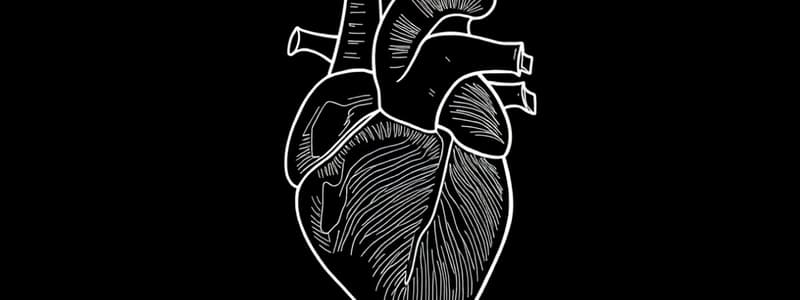Podcast
Questions and Answers
Which class of heart failure (NYHA) is characterized by no limitation of physical activity?
Which class of heart failure (NYHA) is characterized by no limitation of physical activity?
- Class I (correct)
- Class II
- Class IV
- Class III
A heart failure patient with jugular venous distention is likely experiencing:
A heart failure patient with jugular venous distention is likely experiencing:
- Left-sided heart failure
- Diastolic heart failure
- Right-sided heart failure (correct)
- Systolic heart failure
In cardiac rehabilitation Phase II, the typical intensity for aerobic exercise is:
In cardiac rehabilitation Phase II, the typical intensity for aerobic exercise is:
- 40-70% of VO2 max (correct)
- 20-40% of VO2 max
- 10-20% of VO2 max
- Over 70% of VO2 max
Which of the following describes the primary function of the aortic valve?
Which of the following describes the primary function of the aortic valve?
What is the appropriate response if a patient experiences palpitations during a rehabilitation session?
What is the appropriate response if a patient experiences palpitations during a rehabilitation session?
Which factor primarily contributes to atherosclerosis in coronary artery disease (CAD)?
Which factor primarily contributes to atherosclerosis in coronary artery disease (CAD)?
Which of the following best describes angina pectoris?
Which of the following best describes angina pectoris?
In left-sided heart failure, which of the following symptoms is most common?
In left-sided heart failure, which of the following symptoms is most common?
What is the primary function of the right ventricle?
What is the primary function of the right ventricle?
Which exercise is considered low intensity (1-3 METs)?
Which exercise is considered low intensity (1-3 METs)?
A blood pressure increase of more than 220 mmHg systolic during exercise suggests:
A blood pressure increase of more than 220 mmHg systolic during exercise suggests:
Which value is generally considered a healthy ejection fraction (EF)?
Which value is generally considered a healthy ejection fraction (EF)?
Which statement about neurohormonal activation in heart failure is correct?
Which statement about neurohormonal activation in heart failure is correct?
Study Notes
Coronary artery disease (CAD)
- Atherosclerosis is the primary contributor to CAD.
- Endothelial injury and inflammation are the key factors involved in atherosclerosis development.
Angina pectoris
- Angina pectoris is chest pain caused by myocardial oxygen demand exceeding supply.
Left-sided heart failure
- Pulmonary congestion is the most common symptom of left-sided heart failure.
Right ventricle
- The primary function of the right ventricle is to pump blood to the lungs.
Low Intensity Exercise
- Slow walking is considered a low-intensity exercise (1-3 METs).
Exercise and Blood Pressure
- A blood pressure increase of more than 220 mmHg systolic during exercise is an exaggerated response.
- A drop in systolic blood pressure greater than 10 mmHg during exercise may indicate poor cardiac output.
Ejection Fraction (EF)
- A healthy ejection fraction is generally considered to be between 50-70%.
Neurohormonal Activation in Heart Failure
- SNS (Sympathetic Nervous System) and RAAS (Renin-Angiotensin-Aldosterone System) activation increase the workload on the heart.
Types of Heart Failure
- Systolic Heart Failure (HFrEF) is characterized by a reduced ejection fraction.
Cardiac Rehabilitation Monitoring
- Rate of Perceived Exertion (RPE) scale is the best method for monitoring exercise intensity in patients on beta-blockers.
Exercise Intensity and RPE Range
- The target RPE range for moderate-intensity exercise in patients with cardiovascular disease is 6-9.
NYHA Classification of Heart Failure
- Class I heart failure is characterized by no limitation of physical activity.
Right-sided Heart Failure
- A heart failure patient with jugular venous distention is likely experiencing right-sided heart failure.
Cardiac Rehabilitation Phase II
- The typical intensity for aerobic exercise in Cardiac Rehabilitation Phase II is 40-70% of VO2 max.
Exercise Intolerance
- Sudden decrease in respiratory rate is not a common indicator of exercise intolerance.
Diastolic Blood Pressure During Exercise
- Diastolic blood pressure slightly increases or remains unchanged during moderate aerobic exercise in a healthy individual.
Breathing Exercises for Heart Failure
- Diaphragmatic breathing is the most recommended breathing exercise for chronic heart failure.
Function of the Aortic Valve
- The primary function of the aortic valve is to prevent backflow into the left ventricle.
Responding to Palpitations During Rehabilitation
- If a patient experiences palpitations during a rehabilitation session, immediately stop exercise, assess vital signs and reassess the situation.
Studying That Suits You
Use AI to generate personalized quizzes and flashcards to suit your learning preferences.
Description
Test your knowledge on coronary artery disease, angina pectoris, and heart failure symptoms. This quiz covers key concepts including ejection fraction and exercise impact on blood pressure. Perfect for students or healthcare professionals looking to reinforce their understanding of cardiac health.




